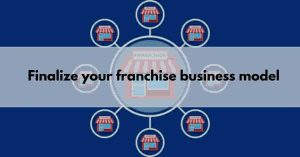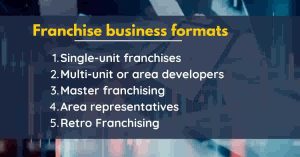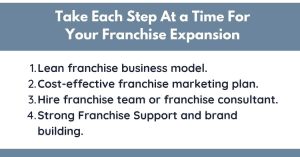If you’re thinking about franchising your business, you’re probably wondering why you should do so. How to franchise your business or not is entirely up to you. Before you decide to franchising your business, though, you should spend some time delving into your own business. This comprehensive guide will help you How to sell a franchise of your business.
While franchising is a great way to expand your business, it can also be quite costly. It can require outside investment and increased overhead, but it can also help you achieve your growth goals.
By franchising, you’ll be selling rights to a brand, which can do more to generate exposure and revenue than you could ever hope to do on your own.
According to the International Franchise Association, just 40% of franchisors have one or more franchisees within a year of starting their business. You can also have one or more franchises in your first year.
You should also know if your business will remain profitable even if you’re not around to run the company.
You should ask yourself below important questions such as what you hope to gain from it long term, what type of brand you want to build, and what kind of business cycles you want to experience.
When Not to Franchise Your Business
The biggest consideration to make when not expanding your small business is whether or not you’ve established a stable business.
Most new businesses aren’t franchise-ready.
For example, you may not have the necessary experience to manage a franchise successfully.
It would help to consider whether you have seasonality in your business. You might want to wait until the cycle has passed if you don’t know.
If your businesses are wildly successful, you’ll want to franchise them. Do you have a franchising business model and systems ready to franchise your business?
|A franchise business requires a proven business prototype and franchise business model.
Franchising your business requires you to train and mentor your franchisees.
If you’re not a business expert, you should consider retaining a professional to help you develop a franchise disclosure document and develop an advertising strategy.
While the franchise industry is highly regulated, it’s still possible for new franchisees to succeed. If you’re unsure about the process, hire a professional franchise consultant to help you.
Ideally, it would help if you waited three years before franchising your business. The market fluctuates, and you should wait three years to see if it’s a good fit.
Before you franchising your business, you should hire staff and monitor your growth.
Remember, franchisees expect you to share in their success, so don’t assume that yours will be the exception. However, if you’re a newbie in the industry, you should wait two or three years.

When Should You Franchise Your Business?
Before you decide to franchise your business, you should first examine your current business model and determine if it can be successfully franchised.
This article will help you understand how well your product or service is suited to the franchise model.
In addition, you should assess any challenges that you have encountered. It would help to consider whether you could adapt the existing operating standards to suit the franchise model.
One of the biggest benefits of franchising is brand name recognition and brand awareness. The increased exposure to the brand name will increase sales.
In addition, a franchised business can take advantage of other resources like a marketing and sales team. Your company can enjoy economies of scale to reduce your costs and liability.
Having a franchised business is a great opportunity for those who want to expand their operations. But before you can choose a partner, it’s crucial to understand your own business.
Ask yourself some important questions, such as:
What is your ultimate goal, what are your long-term objectives, and how are you going to build your brand?
What is your business’s life cycle?
Are you looking to be a multi-unit franchisor?
How to sell a franchise of your business?
Why franchise your business?
Are you wondering why to franchise your business?
It’s an excellent question and an ideal opportunity for many companies.
1. Franchising your business is to maximize your profits.
It is a good idea to set goals and work toward them, which will allow you to focus your efforts on serving your franchisees and helping them reach their goals.
2. Franchising your business is to help others.
While it’s always good to give your employees some freedom and work from home, franchising your own company will allow you to work from the comfort of your own office.
3. Increase your reach.
While it’s natural to want to expand your business, opening new locations requires a lot of energy and time. That’s why many franchise companies choose to franchise their businesses.
With franchising, you’ll be able to focus on what you love about your own business while allowing someone else to focus on your strength and interest.
What are the advantages of franchising your business?
The advantages of franchising your company are numerous. Once you have a good reputation, you can then focus on expanding the scope of your business and attracting more customers.
Many entrepreneurs are concerned with the cost of franchising their businesses. However, the advantages outweigh the disadvantages.
The advantages of franchising may be an excellent option for your company are :
1. You’ll be able to take advantage of existing brand awareness and customer base.
2. You can avoid the risks associated with debt.
3. Buying a franchise is a great way to develop new skills and knowledge.
4. The most significant benefit of franchising is that you can focus on growing your business instead of managing its day-to-day operations.
5. You can also save time and money by outsourcing your bookkeeping.
In some cases, franchise fees can be significantly less than a start-up.
A franchised business is a great way to increase your profits. Because you don’t need to manage employees, franchising allows you to focus on growing your business.
You can focus on expanding your business.
Ultimately, franchising can be an ideal solution for your small business.

How to Franchise your business in five steps:
The five main steps one must implement to give your business a Franchising effect are:
Step 1: Building Brand Influence.
If you want to franchise your business, people need to know who you are and your brand, which you must first establish.
If you believe that people already know who I am and what I do because I’ve been in the sector for more than fifteen years, you should keep in mind that brand perceptions have shifted significantly.
People’s perceptions of brands have shifted; traditional marketing tactics such as newspaper ads, television commercials, and stock holdings are no longer effective; instead, we now live in the digital age.
As a result, the first step in establishing your brand is to utilize social media.
You must have a marketing strategy and a plan in place to ensure that you build a brand around it, and if you do, this is one of the places you should use to do so.
Make sure your presence is there online through social media.
It doesn’t matter how long you’ve been here; what matters is what you’ve accomplished in that time.

Step 2: Finalize your franchise business model.
A coherent business model is required. One could argue that I already run my business and have a business model, but this is not the case.
The franchise business model comprises several elements which are a must to have your franchise ready.
Elements of the Franchise business model
- Franchise business plan
- Franchise financial plan
- Franchise operational manual
- Franchise disclosure document
- Franchise Agreement
- Franchise Marketing Plan
- Franchise Deck Presentation
There are four different franchising business models in the world, and one of these should be your choice.
The four types of franchising models are as follows:
- COCO MODEL- Company-owned and company-operated.
- COFO MODEL- Company-owned and franchise-operated.
- FOCO MODEL: Franchise-owned and company-operated.
- FOFO MODEL- Franchise-owned and franchise-operated.
The FOFO model is regarded as the hero of all the preceding models. At least 60% of franchise businesses use the FOFO model because it gives them more time, builds a team, and gives them more freedom.
Plus, the person who invests in the franchising business (i.e., the franchisee) always feels like it is their business and runs it more efficiently.
Step 3: Build an autopilot system or business prototype.
It’s not only about selling your franchise; any digital marketer or agency can help you do so if you want to sell your franchise.
They’ll create leads for you, and agents and consultants will come to speak on your behalf. They may not do it the way you do it, but they’ll still help you sell it.
If you want to make quick money and obtain a franchise, you can do it any way you want, but if you’re going to do it well and develop a system that will last for generations and leave a legacy, you must follow a systematic plan.
You prepare, nurture your franchise, grow your tribe, build your list, collect your royalty, and build a funnel through the system. Build a plan appropriately so that people can understand how they can come inside your system and work.

Step 4: Generating Franchise Leads.
This step, which is about creating franchise leads, is incredibly significant.
You’ll need decent folks interested in starting a business, and it won’t make sense if you’re getting random leads and merely enquiring like window shoppers.
Franchise leads are generated by targeting suitable people looking to start their own businesses. If you genuinely want to franchise your firm, you must master the art of marketing to produce more leads and propel it forward.

Step 5: Presentation and Sign up Franchisees.
No matter what business you’re in, whether manufacturing, retail, or restaurant, once you create leads and people are aware of them, they want to inquire about your brand, and the technique will remain the same.
So, suppose you don’t present and sign up franchisees systematically when individuals come to you for information. In that case, you’re likely to miss out on potential conversions.
If you don’t have a solid system and strategy for presentations and everything else, people may think you’re new to the industry and won’t choose you. If franchisees approach you, you must ensure that you speak in the appropriate language; this is the most effective way to interact with your franchisees.
Franchising business formats
Consider how you can franchise your firm. Can assist you in franchising any of the following sorts of businesses:

Because of the range of prospects, franchising is an excellent method for people, investment groups, and businesses to become entrepreneurs.
The percentage of franchisors, the diversity of industry sectors represented in franchising, and the wide range of investments available provide potential for everyone from the smallest single-unit to large multimillion-dollar investor groups looking to expand their portfolio with a franchise investment.
1. Single-unit franchises
A single-unit franchise, sometimes known as a direct-unit franchise, says on the tin. A franchisee receives the right to operate one franchise from a franchise system.
This type is the simplest type of franchise arrangement.
Over the years, most franchise systems have developed one franchise at a time. The original most prevalent sort of franchise relationship owns one franchise.
2. Multi-unit or area developers
A multi-unit or area development agreement is a contract that gives a franchisee the ability to create many locations while also requiring them to do so.
It varies from multiple single-unit arrangements. The multi-unit franchisee undertakes to open a certain number of sites within a specific time frame and generally within a particular geographic area.
3. Master franchising
A master franchise arrangement is similar to an area development agreement with one notable exception.
In addition to having the right and duty to establish and run several places in a defined area, the master franchisee also can offer and sell franchises to other people interested in joining the system as franchisees.
4. Area representatives
In a franchise structure, the function of an area representative is very unusual. This person works for the franchisor as a commissioned franchise salesperson and a designated field support worker in a specific geographic area.
The franchisor pays the Area Rep a commission based on a percentage of the franchise price paid to the franchisor for each franchise they sell. They subsequently provide opening and ongoing assistance to the franchisees, earning a portion of the royalty paid to the franchisor.
5. Retro Franchising:
Retro Franchising and franchising are becoming increasingly popular.
Retro Franchising refers to places that were previously franchised but have since been acquired and operated by the franchisor; franchising refers to previously franchised locations but has since been developed and used by the franchisor.

What Are the Franchise Related Laws and FDD?
As part of the pre-sale due diligence process, persons interested in purchasing a U.S. franchise must get a franchise disclosure document (FDD). The booklet includes crucial information for potential franchisees considering a significant investment.
According to the Federal Trade Commission (FTC), every franchisor must disclose 23 particular topics in the FDD, according to the Federal Trade Commission (FTC). The FDD, on the other hand, is not a contract and does not establish a business relationship between the franchisor and the franchisee.
According to the FTC, franchisors must give the franchisee with the FDD at least 14 days before signing it or exchanging any initial funds. After the franchisor receives the application and agrees to consider it, the franchisee is entitled to a copy of the FDD.
How long does it take to franchise my business?
It usually takes 90 to 120 days to franchise your company. There may be differences based upon several elements specific to your company or sector, and many things depend upon your internal team and whom you’re working with.
According to my experience, reputable franchise consultants will require more days because they have many clients to serve. I recommend using templates to generate your franchise documents.
You can use our customized franchise documents services if you don’t want to alter or are too busy with your expansion activities.

Franchise Recruitment Stages
In the end, it is determined by the people with whom you collaborate.
It’s vital to remember that there are two steps to the franchise development cycle when determining the cost to franchise your business
Stage 1: The Franchise Development Stage.
This step is where you pursue the business and legal procedures to become a franchisor and begin offering franchises.
Creating and releasing your franchise model and franchise documentation, starting your operations manual, and strategically assessing your franchise offer compared to your rivals are all critical stages in the franchise development stage.
Stage 2: The Franchise Sales Stage.
Following the issuance of your FDD, this is the initial step of your franchise sales cycle. During the early franchise sales period, you’ll be selling franchises using several marketing channels, such as paid advertising, organic attraction, public relations, social media marketing, and franchise brokers.
The franchise growth process is discovered to be an ever-evolving process that happens over the years as your franchise system grows and improves.
To figure out how much it will cost to franchise your firm, we’ll start with step one, which includes:
- Placing your franchise options, as well as the fundamental rights and duties between you and your franchisees, in a competitive market,
- Producing your Franchise Disclosure Document (FDD) and the rest of the legal infrastructure required to become a franchisor and begin selling franchises legally and correctly, and
- The creation of your company’s operations manual.

How much does it cost to franchise my business?
We’ve seen costs range from $18,500 to $84,500 to get this accomplished, based on whom you operate with and whether you write your operations manual.
We prefer to reduce franchisor expenses to benefit both the franchisor and the franchisee. Using our templates or customized franchise model and completing the first stage will cost you $ 1000 and $5,000.
We can expect to pay between $ 1000 and $ 5000 for bespoke business models, FDDs, and other franchise paperwork in the first step. We’ll hire the top franchise experts from across the world to create a unique franchise business strategy for you.
Legalzoom also provides excellent legal services in the United States, such as franchise disclosure documents, firm start-up registrations, and other legal documents.
You can develop your lean marketing plan with less budget of $ 100 per month and as much as $ 500 per month for the second stage.
Your region and demographics heavily influence the cost of acquisition. I’ll look into it and try to get as many franchise consultants as possible on the same page to find a solution.
It also solves the subject of how to franchise your small business.
We offer uniform solutions for franchising your small, medium, or large firm; we don’t discriminate based on size.
Developing your franchise marketing plan
There are many changing factors for selling your first franchise and developing a funnel for future franchise sales. To offer franchisees at a low cost, you’ll need to design a marketing strategy.
It would be suitable to dig right in and look at this by industry. The following are three crucial questions that will determine your franchise marketing strategy.
- What industry are you in?
- Are you looking for someone who will be converting an existing business into your type of business?
- Are you looking for someone who will start a brand-new business?
Creating leads and knowing the specific demography of the people you want to attract, then funneling them into a funnel.
Getting numerous stages in place so that people learn about you, become interested in you, and eventually join your pipeline, and do it regularly.
You can create leads by any of the following:
- Franchise Email Marketing.
- Google Ads.
- SEO.
- Franchise Social media marketing.
- Referral program.
We are working on a low-cost franchise marketing and lead generation plan for you to cost $100 – $ 500 monthly.
Conclusion: How to make your business a franchise
Now you know that franchising has many benefits, including capital, speed of growth, motivated management, and risk reduction. Developing a franchise business plan is one of the most critical steps of the franchise process. It is crucial to understand the franchisee’s objectives, especially in the early stages of the business. If you’re considering franchising, you should also understand how it works. I hope this article makes you understand how to franchise your business.
We can conclude that a start-up franchisor will require the help of franchise consultants or a franchise attorney to prepare to sell your franchise business opportunity.
To make the franchise business opportunity profitable, the franchise business model must be well-directed, and the franchise finance model must make sense.

All checks will ensure that your franchise business is profitable and successful, generating profits for both the franchisor and the franchisee.
With all we’ve shared with you, you can start franchising your business right now!
If you have any questions about franchising your business, please leave them in the comments section. You can also share your experiences and opinions on the subject.


Franchising a business is required for the growth of any business whether small or on a very large scale. Thanks to franchisedeck for this helpful article.
hey
How to franchise your business is good information to share
Hey
How to franchise your business is good information to share its help to grow my business whether small or on a very large scale
Hey
How to franchise your business is good tips
Thank franchise-deck to share great information
Develop a business plan that outlines the costs associated with franchising and potential revenue projections.
innovate and improve your franchise system to keep it attractive to potential franchisees.
Analyze your business model to determine whether franchising is the right move for your business. Research the legal, financial, and operational requirements of franchising. Develop a business plan for your franchise concept.
Select a franchise attorney and accountant to assist you with the franchise process. Establish a Franchise Disclosure Document (FDD), which outlines the structure of the franchise and its associated costs.
Identify potential franchisees and develop recruitment materials. Develop an operations manual that outlines all of the procedures, standards, and systems for franchisees and their employees.
Create a marketing plan that outlines your strategies for promoting the franchise. Create a franchise agreement that sets out the terms and conditions of the franchise.
Choose the right franchisees who will be able to best represent your business.
Provide training and support for your franchisees. Monitor the performance of your franchisees to ensure they are meeting the standards of your business.
Keep in contact with your franchisees to provide ongoing support and guidance.
Continue to refine your business model and franchising process as needed. Ensure that you are compliant with all state and federal franchise regulations.